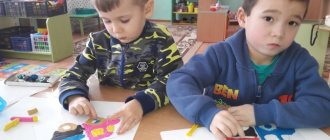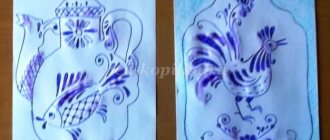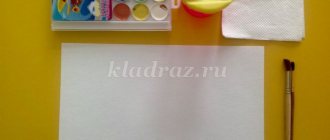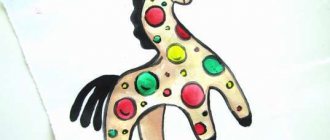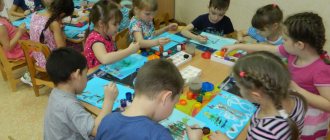Tips for organizing and conducting classes
In general, the broad topic “Transport” is considered in the process of complex pedagogical work aimed at cognitive-research, speech, social-communicative, artistic and aesthetic development, the formation of a holistic picture of the world and the foundations of safe life. Drawing classes can be conducted in a narrowly focused format or as part of short-term and long-term projects on this topic (“Modes of transport”, “Safe behavior on the roads”, “Urban transport”, etc.).
Children create a collage as part of the “Modes of Transport” project
Photo gallery: individual works on the topic “Transport”
“Journey to a Magic Land” (watercolor)
“Firetruck” (watercolor and pencils) “We are going, going, going” (watercolor and felt-tip pens)
“Harvest” (watercolor and felt-tip pens)
"Sailboat"
“Passenger car” (felt-tip pens)
Large plot compositions, which consist of many different elements, are usually created collectively. The preparatory stage, during which the background is painted over, individual parts or figures are drawn and cut out, is carried out in small subgroups of 3-4 people, and then the children together make a picture on whatman paper, gluing the silhouettes they have prepared.
It is important to pay close attention to the problem of working out how children follow the correct sequence of work to create a plot composition or collage: first you need to make a background drawing (road, sky, sea, space), painting the entire space of whatman paper, then draw background objects (houses, trees, flowers, people, etc.) and only then draw or place previously prepared and cut out silhouettes of cars. When creating a collective drawing, children are guided by a given condition or design, and the process of collective work itself develops spatial thinking, skills of mutual understanding and camaraderie.
Photo gallery: collective works - collages
“City streets” “Modes of transport”
"Our town"
"Cars are driving down the street"
Structure of a drawing lesson on the topic “Transport”
In the senior group, standard long-term planning provides for one drawing lesson per week. The total duration of continuous activity should not exceed 20–25 minutes; methodological manuals recommend performing physical exercises (finger, breathing, motor exercises) for 5 minutes for relaxation and prevention of mental and physical fatigue in children.
- The organizational part - the information and familiarization stage involves awakening children's interest in the depicted object, studying its shape, color and components. It is necessary to include playful and surprise moments, reading poems, fiction, demonstrating visual material, watching cartoons, educational films and presentations that stimulate curiosity, cause a positive emotional reaction and activity.
- Practical part - the teacher explains the sequence of drawing parts after examining the object (3-5 minutes). Older preschoolers are given more freedom in the drawing process. Demonstration of a picture or sample prepared by the teacher should not be used for copying, but only for the formation of a correct understanding of the task or its clarification. The work is done from life or on the basis of life experience and observation; the basic techniques have already been mastered, so they do not require additional demonstration. Explanation algorithm for children:
- Draw the children's attention to the shape of the body, clarify in an additional question what shape it resembles (rectangle).
- Ask to compare the shapes and sizes of the cabin and the body, ask what is the difference (the cabin has one corner cut off and one side drawn at an angle).
- Discuss the shape of the wheels and their location in relation to other parts of the car (one wheel under the body, the other under the cab). It is worth noting that children often draw wheels at random, shifting their location.
- It makes sense to remind you that you need to start work by drawing the largest part, i.e. the body, placing it not too close to the bottom edge of the sheet, leaving room for the wheels.
- It is necessary to ensure that the work is carried out in the correct sequence, correctly conveying the shape, size and proportional relationship of the parts of the machine, and also pay attention to the fact that children carefully paint over the silhouette of the machine and the background, and thoughtfully draw minor background details (houses, trees, traffic lights, etc. .), making up a plot drawing.
- Independent work of children (15–20 minutes).
- The final part - children's images are compared with the object, the degree of similarity between the original and the artistic copy is assessed (3 minutes).
Table: example of the organizational part of a lesson on drawing transport
| Author and theme of GCD | Contents of the stage |
| O. Kotlobay “Under the blue sky” | — Guys, I’ll tell you an amazing story (music plays until the end of the story). A long time ago, when people only dreamed of flying like birds, and there were no airplanes, no helicopters, or even hot air balloons, the famous master and inventor Daedalus lived in Ancient Greece. The fame of him reached the ruler of the island of Crete, King Minos. He ordered Daedalus to build a huge labyrinth for the monster Minotaur - many intricate passages among high walls, from which it was impossible to find a way out. Daedalus carried out the order. But the evil king Minos imprisoned the inventor Daedalus and his son Icarus in it. It was possible to escape from there only by miracle. And Daedalus performed a miracle - he made wings for himself and his son, and they flew to freedom. The wings were made from bird feathers, held together with wax glue. Daedalus warned his son not to fly too high, otherwise the wax would melt under the hot rays of the Sun and the wings would disintegrate into small feathers. But Icarus enjoyed flying so much, soaring in the sky like a bird, that he forgot his father’s warning and rose higher and higher. The wax melted and Icarus fell into the sea. People still keep the legend of Icarus, for whom flight was more important than life. And in memory of him, many inventors tried to make an aircraft that would be more reliable than wax wings. |
Thanks to them, you and I can fly. But as? You will find out when you solve the riddle:
- Did you guess? This is a plane. What other flight devices do you know? (Children name air transport, and the teacher shows pictures). How is air transport different from ground transport? It should have a streamlined shape, i.e., without corners, to make it easier to cut through the air. What shapes without corners do you know? Circle and oval (figures are drawn in the air with a finger). You also need a narrow nose to fly faster, wings to stay in the air. It should be made of lightweight materials, sometimes a screw or propeller is attached to fly up and forward (during the discussion, the teacher shows models of an airplane and a helicopter; children draw wings in the air - triangles, show the propeller with rotational movements). | |
| That's how much you already know about air transport. The word "avi" is translated from Latin as "bird". Today you will be aircraft designers - people who design and build aircraft. |
Video: educational cartoon “Fire Truck”
Photo gallery: step-by-step schemes for drawing transport
Fire truck Car with van
Steam locomotive Fuel locomotive Truck
Passenger car Steamboat
Tractor
sailboat
Rocket
Airplane
Helicopter
Content
Progress of the lesson.
1.Org. moment: Children stand in a semicircle. The teacher asks you to guess the riddle:
Educator: He is big and very heavy.
He's used to carrying loads
What kind of car is this?
Everyone knows - (Truck).
Educator: Children, let's look carefully in the group and find where our truck is hidden.
The children find a truck and sit in a semicircle on the carpet.
Educator: Well done!
2. Main part
Educator: Let's look at our truck.
Table: summary of a drawing lesson by E. Sidorova on the topic “Passenger car”
| GCD stage | Contents of the stage |
| Preparatory stage | Purpose of the lesson: to introduce children to a passenger car, the history of its creation, and its purpose. Objectives: Teach children to draw passenger vehicles, convey the structural features of the car, adhere to the proposed sequence of a detailed image of the object. Strengthen your painting skills: apply strokes evenly in one direction without visible gaps, do not go beyond the contour of the finished silhouette. Develop compositional skills. Materials for work: A4 landscape sheet; a simple pencil; eraser; a set of colored pencils or wax crayons; drawings or photo illustrations depicting different brands of cars. Musical series: audio recording of the song “Dad bought a car”, music by A. Pugacheva, words by O. Milyavsky. Preliminary work: targeted walk to the roadway, stop, observation of passenger transport. Examination of drawings or photo illustrations depicting different brands of cars in free time. |
| Organizational part | The teacher asks the children to guess the riddle:
- Right. Children, we received an order from a car store; they sold out all the cars that were in stock. So the store director asked to replenish the showroom with new cars. |
| Main part | 1. Conversation about transport. — Now it is very difficult to imagine our life without cars. But there was a time when people traveled long distances on foot or on horseback. This took a lot of time and effort. The first car was clumsy and funny in appearance: in front there was a steam boiler with a smoking pipe, in the middle there was a driver’s seat, and the whole structure rolled on three wheels. The boiler was heated with wood, the water boiled in it, and steam was produced, which set the car engine in motion. The driver controlled the car not with a steering wheel, but with the help of levers. The car was driving very slowly, rattling loudly, snorting, whistling, which horrified passers-by. But at the same time, it also caused delight, since it moved on its own, not without reason receiving its name from two Greek words: “auto” - which means “oneself”, “mobile” - “movement”. Much later, a car was designed that no longer had a boiler or firebox; its new engine ran on gasoline. Nowadays there are many different cars. Cars differ in size, color, body type. But, despite the diversity, they all have a similar structure: they have a metal body - the basis of the car, headlights are attached to the outside of the body at the front, and lights at the back. Inside the body - in the cabin - there are seats for the driver and passengers, there is also a steering wheel, gear shift levers and all the instruments for driving the car. From the salon you can look out onto the street through the windows. In the front part of the body, under the hood, there is an engine, or otherwise called a motor. At the rear of the car there is a trunk for transporting cargo. The chassis is attached to the lower part of the body, otherwise it is called the chassis, it is like a cart with wheels that carries a small house on itself. Any car is equipped with a loud sound signal in order to promptly warn of its approach those pedestrians who are inattentive on the road. Reading the poem "Bi-Bi".
— A modern passenger car has everything to make traveling in it comfortable: a radio built into the dashboard, air conditioning, an autopilot that helps the driver control the car. Each seat is equipped with seat belts that save a person in the event of an accident. A passenger car can carry no more than three or four passengers at a time, not counting the driver. This is probably why the car is called a passenger car, since it is not large in size, carries few people and a minimum of cargo, that is, it travels light, unlike a heavy-duty vehicle. Passenger cars are most convenient for traveling to the country, to the store, to work. Physical school
2. Practical part. Stages of work execution. Children draw a contour drawing of a car with a simple pencil, relying on the teacher’s verbal explanation and his demonstration of techniques for detailed drawing of an object. The teacher reminds that you should always start drawing in the center (middle) of the sheet, the object should not be too small, but not too large, on the entire sheet, there should be free space around it to depict any additional objects, elements, so that it turns out a single thematic composition.
Warm-up for hands “Wind-up cars!”
3. Independent work of children. |
| Lesson summary | After the work is completed, the drawings are displayed for general review. - Children, you tried very hard, now the store’s showroom is full of new cars, and everyone can choose a car according to their taste and color. Or it may happen that your dad comes into the store and buys a car, and then takes you for a ride around the city. You can play an audio recording of the song “Dad Bought a Car” and invite the children to take a ride in their “little cars.” |
List of used literature
Program from Birth to School
Similar works
Pedagogical conditions for teaching drawing to children 2-3 years old
Finalization of the client's order: Formation of the foundations of visual literacy in young children in painting with paint 3
Finalization of the client’s order: Formation of the basics of visual literacy in young children in painting with paint
formation of imagination in primary school children in lessons using folk toys 3
formation of imagination in primary school children in lessons using folk toys 2
Artistic and aesthetic activities in preschool educational institutions as a means of developing children’s creative abilities in fine art classes (drawing, older age)
Organization of work on teaching children of senior preschool age the technique of depicting folk ornaments in classes and in independent activities 2
Development of dialogical speech of middle preschool children using small forms of folklore
Development of dialogical speech of middle preschool children using small forms of folklore 2
How to draw a truck
First I want to offer a simple option. I think every parent will be able to show their child the drawing sequence, and then he will try it himself.
1. Using a simple pencil on a sheet of paper, draw two rectangles: a large one and a small one, like this.
2. Next we draw the upper part of the cabin and two wheels.
3. Draw small details on the cabin, wheels, headlights. Erase the extra lines.
4. If desired, you can color with colored pencils, felt-tip pens or paints.
The result is a cargo van like this.
The entire sequence of images can be viewed in the gallery by clicking on any picture, moving along the arrows to the right or left.
How to draw a truck step by step
The second option is suitable for older children. I will show you in detail step by step how to depict another truck.
1. To make it easier to draw, first draw thin horizontal lines at the same distance in the center of the sheet.
2. Draw the truck cabin, guided by the lines.
3. Add the body.
4. Next we draw the wheels.
5. Add additional body and cabin parts.
6. Draw the cabin, body, wheels, headlights. Erase the extra lines.
7. Color with whatever you like. We did it with paints.
The entire sequence of images can be viewed in the gallery by clicking on any picture, moving along the arrows to the right or left.
Now you know how to draw a truck and can show your child the whole process step by step. I wish you creative success and a great mood!
Read here how to draw a cat.
If this article was useful to you, please share it with your friends by clicking on the social media buttons.
Source
Drawings by students of the senior group on the topic “Transport” with comments on the performance of the work
Photo: samples of drawings on the theme “Truck”
Trucks in children's drawings often carry crops. This is, for example, the work “Trucks Carrying Grain”, where images of cars are harmoniously complemented by a suitable background. There is even a traffic light, which preschoolers love to draw. The composition “Bringing the Harvest” is interesting because the cars are drawn in the foreground and background. The vehicles in this pencil drawing are rendered very realistically.
The picturesque landscape is presented in the composition “Funny Truck”: trees drawn with multi-colored wax crayons look like fairy tales.
The trucker's van in the drawing "Trucker" is depicted very realistically, although the preschooler chose gloomy colors for the image.
An interesting work is “Dolroga and We”, which captures a panorama of the city - an intersection with a road sign, a traffic light and a pedestrian walking along a zebra crossing.
Drawing with wax crayons
Watercolor drawing
Pencil drawing
Watercolor drawing
Pencil drawing
Pencil drawing
Photo gallery "Cars"
An expressive image was created in the drawing “Red Car”. The composition is imbued with a positive atmosphere: the cheerful sun is shining in the sky, a multi-colored traffic light rises at the edge of the road, cute flowers peek out from the green grass. The use of felt-tip pens makes the composition bright and rich.
Similar to the previous work “Car and Traffic Light”, done in watercolor. The image of a car racing along a highway against a backdrop of trees and bright sun is well conveyed here.
In the picture “Cars on the Road,” cars are driving next to a bus and an excavator.
Watercolor drawing Pencil drawing
Drawing with felt-tip pens
Photo gallery "Fire trucks"
The plot composition is presented in the figure “A fire truck came to put out the fire”: we see a fire that engulfed the top floor of the house. There is also a plot in the work “Fire Truck to the Rescue”: here an assistant car extinguishes a passenger car that has caught fire.
The vehicle in the work “Fire Truck” is drawn in detail: the cabin has a characteristic color, and there is a fire escape on the body.
Watercolor drawing
Drawing with felt-tip pens
Pencil drawing
Photo gallery "Tractor"
As practice shows, children are good at drawing a tractor. After all, this agricultural machine has characteristic distinctive details - large rear wheels, a pipe on the hood. The work “Tractor” is very original, made using an unconventional technique - the body of the car is drawn using a child’s foot (similar to palm typing). In addition, the ribbed surface of the wheels is drawn very realistically with a black felt-tip pen.
A green tractor is realistically depicted in the drawing “Tractors went out into the field.” The car in the pencil drawing is shown with a trailer.
Watercolor drawing
Drawing in an unconventional technique - feet
Pencil drawing
Photo gallery "Ambulance"
Children's drawings depict images of ambulances very realistically. In “Ambulance to the Rescue,” we even see a patient looking out of a car window.
Pencil drawing
Drawing with felt-tip pens
Photo gallery “Maritime transport”
Interpretations on the theme of water transport are worthy of attention—pupils from the senior group create very expressive images of ships. A bright and colorful ship is painted in watercolor (“Boat”). The sailboat in the drawing “The Current Carries Me,” on the contrary, is made in soft pastel colors. In the work “Elegant Steamship,” the sea vessel is decorated with decorative paintings and resembles a Dymkovo toy.
We see a wonderful plot composition in the drawing “Ships in the Roadstead” - ships of different sizes and colors walk on the waves against the backdrop of a bright yellow sun, clouds and seagulls. With help. felt-tip pens beautifully convey the blue surface of the sea. The “Jolly Ship” drawing was made using an unconventional technique - poking. We see the majestic ship in the picture of the same name: the yellow color of the ship favorably sets off the blue color of the sea.
Watercolor drawing
Watercolor drawing
Watercolor drawing
Drawing with felt-tip pens
Drawing using the poke method
Pencil drawing
Watercolor drawing
Watercolor drawing
Preview:
"People's Labor in Spring Tractor"
Spring has come. And a troublesome, responsible time has begun for grain growers and agricultural producers. They have to carry out all agricultural work on time, sow wheat, barley, oats, rye, and other crops. People's work in spring is special. Spring day feeds you all year long. A day earlier you sow, a week earlier you reap.
The snow will melt in a clean field,
Melt water will subside -
Runs behind the tractor driver
There is a furrow to the blue river.
The seeders will come out later
Sowing fields with grain.
During the winter, the ground was compressed under the snow and became hard. Seeds cannot be planted in such soil. Therefore, as soon as the snow melts, the tractor driver takes the tractor out to the field and begins to plow the land.
He plows so that the earth becomes soft and begins to breathe.
The tractor plows the ground using a plow that is attached to the rear. After the plow, large lumps remain, so that the field becomes smooth without lumps, it is loosened. A harrow is attached to the tractor. With the help of which the lumps are broken. To sow seeds, a seeder is attached to the tractor. The tractor driver performs a huge and important job. He works from early morning until late evening, because he needs to have time to sow all the fields during the spring months.
Pencil drawing diagram - a tractor with a plow.
Source
